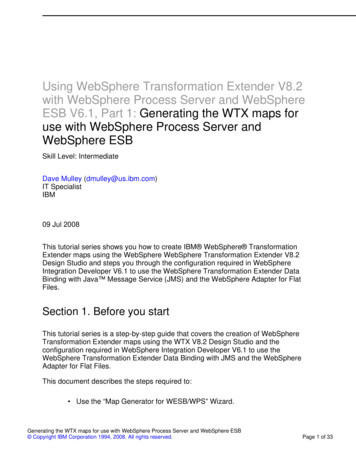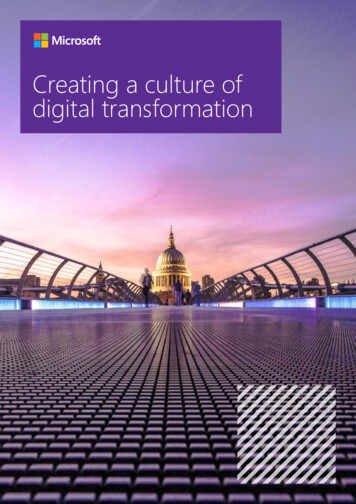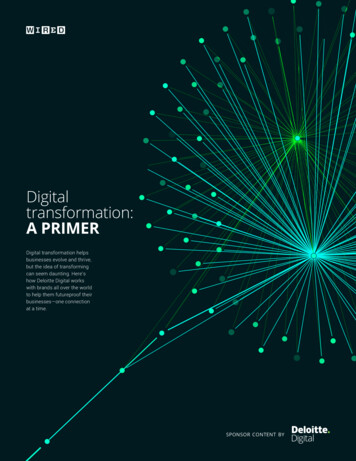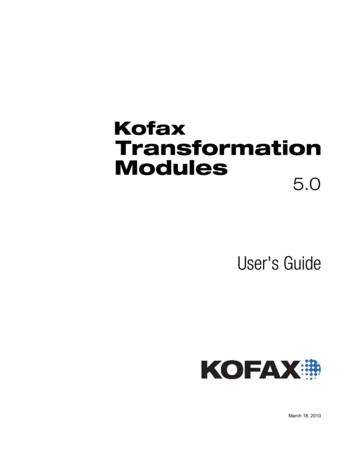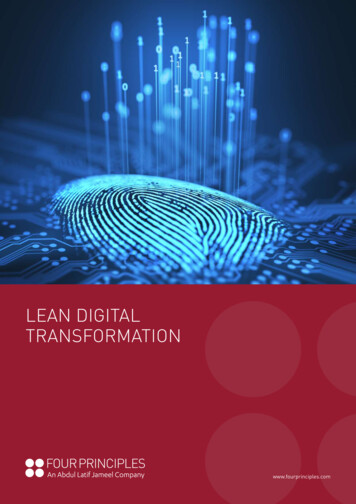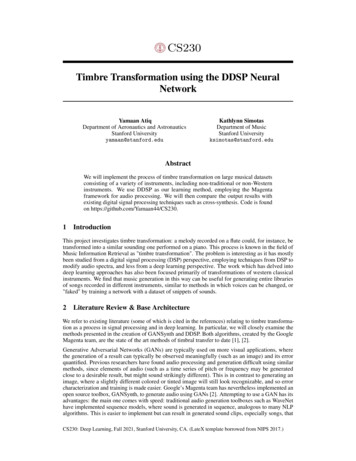
Transcription
Timbre Transformation using the DDSP NeuralNetworkYamaan AtiqDepartment of Aeronautics and AstronauticsStanford Universityyamaan@stanford.eduKathlynn SimotasDepartment of MusicStanford Universityksimotas@stanford.eduAbstractWe will implement the process of timbre transformation on large musical datasetsconsisting of a variety of instruments, including non-traditional or non-Westerninstruments. We use DDSP as our learning method, employing the Magentaframework for audio processing. We will then compare the output results withexisting digital signal processing techniques such as cross-synthesis. Code is foundon s project investigates timbre transformation: a melody recorded on a flute could, for instance, betransformed into a similar sounding one performed on a piano. This process is known in the field ofMusic Information Retrieval as "timbre transformation". The problem is interesting as it has mostlybeen studied from a digital signal processing (DSP) perspective, employing techniques from DSP tomodify audio spectra, and less from a deep learning perspective. The work which has delved intodeep learning approaches has also been focused primarily of transformations of western classicalinstruments. We find that music generation in this way can be useful for generating entire librariesof songs recorded in different instruments, similar to methods in which voices can be changed, or"faked" by training a network with a dataset of snippets of sounds.2Literature Review & Base ArchitectureWe refer to existing literature (some of which is cited in the references) relating to timbre transformation as a process in signal processing and in deep learning. In particular, we will closely examine themethods presented in the creation of GANSynth and DDSP. Both algorithms, created by the GoogleMagenta team, are the state of the art methods of timbral transfer to date [1], [2].Generative Adversarial Networks (GANs) are typically used on more visual applications, wherethe generation of a result can typically be observed meaningfully (such as an image) and its errorquantified. Previous researchers have found audio processing and generation difficult using similarmethods, since elements of audio (such as a time series of pitch or frequency may be generatedclose to a desirable result, but might sound strikingly different). This is in contrast to generating animage, where a slightly different colored or tinted image will still look recognizable, and so errorcharacterization and training is made easier. Google’s Magenta team has nevertheless implemented anopen source toolbox, GANSynth, to generate audio using GANs [2]. Attempting to use a GAN has itsadvantages: the main one comes with speed: traditional audio generation toolboxes such as WaveNethave implemented sequence models, where sound is generated in sequence, analogous to many NLPalgorithms. This is easier to implement but can result in generated sound clips, especially songs, thatCS230: Deep Learning, Fall 2021, Stanford University, CA. (LateX template borrowed from NIPS 2017.)
do not sound cohesive. Contextual clues from a later time in a song are not used to inform soundearlier. This is also slower, as each sample is used for the next, and so there are specialized kernelsrequired to parallelize generation. GANs tackle both of these issues by generating an entire audiosequence at once, making a clip more cohesive by making use of audio at earlier and later timesteps tolook for context clues. Further, samples are not generated sequentially, so the entire clip is generatedmore efficiently. The Magenta team acknowledges that GANs fall short in cohesiveness on a localtimescale, even when the overall clip sounds more cohesive - this decreases overall quality of anaudio clip. GANSynth addresses this issue by using instantaneous frequencies and log magnitudes inits model, and yields better results.(b) Encoder Blocks(a) DDSP Architecture(d) Multilayer Perceptron (MLP) Blocks(c) Decoder BlocksFigure 1: DDSP Blocks [3]Differentiable Digital Signal Processing (DDSP) takes a completely different approach to the frequency domain one used by GANSynth [3]. GANSynth still does not necessarily yield subjectively"good" sounding audio - DDSP meanwhile uses the way sound is perceived using vocoders andsynthesizers to separate audio generation in to elements typically used to electronically generatemusic. Signal processing has historically been difficult to integrate with modern machine learningarchitectures which use autodifferentiation. The DDSP library is built into modules which arecompatible with autodifferentiating NNs, allowing the user to focus on specific modules and controlelements like pitch and loudness independently. Figure 1 shows the architecture from the originalpaper, showing integration of deep learning blocks with traditional signal processing blocks. Thismakes DDSP an ideal choice for timbre transformation, which is an inherently perceiving problemwith learned elements.3DatasetTo gain access to non-Western instrument data and non instrument sounds, we use the AudioSetdataset which consists of TFRecord representations of more than 2 million 10 second clips fromYoutube videos sampled at 16kHz [7]. Each clip is rigorously labeled by instrument and sound type,although many clips contain multiple labels and instruments in them for the same clip. The labels weare most interested in using for our timbre transformation process are the harp, accordion, bagpipes,didgeridoo, and theremin which have for each of them individually between 2,800 and 600 entries(including entries with more than one label). We are also planning to conduct an experiment withtimbre transfer using bird songs as well as using more polyphonic instruments and musical settingslike the harmonica, orchestra, and choir.We initially planned to use our Youtube clips in their original TFRecord format, separating themby label with a custom script. However, we quickly discovered that the format of the dataset wasincompatible with either our original framework idea, GANSynth, or DDSP. Therefore, we decidedto find a way to recover the raw audio data from AudioSet and repackage it as readable data. Thisdoes introduce new challenges in our approach, however, namely devising a method for changingdata formats such that the original data and labels are maintained as best as possible. There is also aninherent challenge with this dataset that data has multiple labels, which is not ideal for learning for2
the purposes of timbre transformation. At best, data for timbre transformation has historically beenmonophonic, single-instrument data, however, in order to conduct transformation on lesser known orless popular instruments or background noises, we must accept datasets that provide such choices,even if it comes at some cost to the amount of usable data we have or to some extent the quality ofthe data.4ApproachSince NSynth files were used to train the GANSynth model, their weights were optimized to takeNSynth input files. The Magenta library does not provide a function or class for pre-processing inputmp3 or wav file types in to NSynth TFRecord files, so carrying over some pre-trained weights toapply transfer learning to a new dataset of mp3 files renders the optimized weights not meaningful.In this sense we discovered GANSynth is limiting in its ability to apply transfer learning.The solution to this was to train the network from scratch, and we have opted for a different modelfrom the Magenta DDSP Library for this training to simplify the scope and avoid retraining onNSynth, which would be too computationally expensive. We use the DDSP Autoencoder, whichconsists of three separate and distinct neural networks training on different aspects of the data. Thepitch or frequency encoder uses a residual convolution neural network, while both the loudness andresidual vector encoders use GRUs. Since the overall architecture is differential, the neural networkscan be trained together under an SGD optimizer. The losses used by the overall architecture are themulti-scale spectral (which compares the magnitude spectra of the original and reconstructed signalsusing L1 losses) and perceptual losses for the frequency encoder (which is also calculated using anL1 loss and weighting factor relative to the spectral loss)(3).Our approach is implemented as follows:1. The Audioset dataset is a CSV file encoding information about a large collection of Youtubevideos, and so there is a preprocessing step required to extract the audio in to some formatreadable by our model.2. We employ the AudioSet processing toolbox developed by Aoife Mcdonagh to do accessthe original audio information via wav files. We use this framework to download audioassociated with the video within the set time interval specified in the CSV versions of thedata. One of our hyperparameters to tune is the size of the training set - more specifically,we would like to determine a sufficient minimum size for the training set, as when using theentire Theremin set of training clips we did not obtain entirely desirable output. [4]3. DDSP Autoencoder to preprocesses audio files into a format with meaningful statistics formodel to be trained on. wav files must be turned into TFRecord files, similar to the onesused by GANSynth, that NSynth provided.4. Train the model using the TFRecord dataset. TFRecord files encode all information neededfor training, features such as loudness and fundamental frequency, so we do not need toprovide any more training examples.5. We trained the model using Magenta’s DDSP solo instrument gin model. For a dataset of637 training examples for the Theremin, this took about 2 hours on a GPU. We noted that ataround 12,000-15,000 steps the loss was constantly fluctuating around 5-10, the measure atwhich it says the model is trained. It is possible that our model is overfitting the data here atleast in our initial experiment.6. Export the model as a checkpoint for Magenta’s Timbre Transfer skeleton. We have alreadygenerated our DDSP model containing weights, so all that is left is to synthesize audio.7. Upload an input sound clip of sound to use with our synthesizing code. As an example, weshow a clip of singing whose characteristics and output are discussed more in the resultssection.5WorkflowShown below is a flowchart summarizing the workflow steps from the input dataset to the outputsynthesized audio.3
AudioSetDataset(.csv)SynthesizedAudio et(.wav)ModelCheckpointExport rd)DDSPModelTrainingUser InputAudio(.wav)6Results(a) Input Singing Spectrogram(b) Output Theremin SpectrogramFigure 2: Spectrogram Comparison between input and outputThe spectrograms between the original and synthesized audio clips look reasonably similar in shapeand color, but sound very different. In particular, there are some significant jumps periodically in thesynthesized data which seem to be artefacts of the model potentially overfitting and adding extraneousfeatures.(a) Input Singing Spectrogram(b) Output Bagpipe SpectrogramFigure 3: Spectrogram Comparison between input and output6.1Training and Loss FunctionWe trained the DDSP solo instrument model on two different instruments, the theremin and thebagpipes both using the default hyperparameters and batch sizes of 16. For the theremin we had 3,000examples of 4 second clips and for the bagpipes we had 12,000. The DDSP model uses both spectralloss (described in one of the DDSP paper’s citations, Wang et. al. 2019) and L1 loss functions.The total loss is calculated using the original and synthesized magnitude spectrograms, Si and Ssirespectively using the following equation:4
Li Si Ssi 1 α logSi logSsi 1For the theremin we trained over approximately 12,000 epochs and for the bagpipes approximately30,000.Figure 4: Theremin Loss Function for 4.5k training stepsFigure 5: Bagpipe Loss Function for 30k training steps6.2Error Characterization and Model ImprovementTimbre in general is difficult to characterize quantitatively. Timbre transfer itself is a highly subjectiveprocess to evaluate, and so in this project, we determined the best method of error characterization touse was comparing a time series of fundamental frequency f0 and computing the root mean squaredeviation between an input sound clip and the output. We show a plot of f0 for the bagpipes in Figure6 and compute the RMS deviation, which we find to be 20.27 for the bagpipes and 19.66 for thetheremin. It is worth mentioning that this metric is flawed - a better method of characterizing thetimbre transfer effectiveness would be to train another neural network on various input and outputclips for the synthesizer to determine how well timbre transfer has worked. But replicating thefundamental of the original input is an essential first step of timbre transfer, so this was the mostaccessible and illuminating quantitative error measurement in our view.7Future WorkFuture work would involve model improvement and model evaluation. Firstly, we need to improvethe model as our generated results are not showing the synthesis we expect. We need to be carefulabout the conclusions we make given the inherent background noise in our dataset, as well as decidewhether or not to limit our data to only those with single labels (less background noise). It is alsopossible our model is overfitting, so we need to evaluate the model quantitatively and then improve themodel’s synthesis by tuning hyperparameters - we believe a large part of this is the input dataset size,so it is possible that by splitting the dataset into minibatches, we might improve our performance.The model evaluation is coupled with this - we need to define specific metrics to quantitativelyevaluate the model. As audio is a highly qualitative process, in getting the model running we havemainly been using playback to check performance. Over the course of a larger dataset, performancemetrics would be necessary here.5
Figure 6: Fundamental Original vs Resynthesized for Bagpipe Model[1] Alexander, J.A. & Mozer, M.C. (1995) Template-based algorithms for connectionist rule extraction. InG. Tesauro, D.S. Touretzky and T.K. Leen (eds.), Advances in Neural Information Processing Systems 7, pp.609–616. Cambridge, MA: MIT Press.[2] Bower, J.M. & Beeman, D. (1995) The Book of GENESIS: Exploring Realistic Neural Models with theGEneral NEural SImulation System. New York: TELOS/Springer–Verlag.[3] Hasselmo, M.E., Schnell, E. & Barkai, E. (1995) Dynamics of learning and recall at excitatory recurrentsynapses and cholinergic modulation in rat hippocampal region CA3. Journal of Neuroscience 15(7):5249-5262.[4] Mcdonagh, A. (n.d.). Aoifemcdonagh/audioset-processing: Toolkit for downloading and processing Google’sAudioSet dataset. GitHub. Retrieved November 8, 2021, from g.References[1] C OSMIR. cosmir/dev-set-builder: Boostrapping weak multi-instrument classifiers to build a developmentdataset with the open-mic taxonomy.[2] E NGEL , J., AGRAWAL , K. K., C HEN , S., G ULRAJANI , I., D ONAHUE , C.,Adversarial neural audio synthesis.ANDROBERTS , A. Gansynth:[3] E NGEL , J., H ANTRAKUL , L. H., G U , C., AND ROBERTS , A. Ddsp: Differentiable digital signalprocessing. In International Conference on Learning Representations (2020).[4] E NGEL , J., R ESNICK , C., ROBERTS , A., D IELEMAN , S., E CK , D., S IMONYAN , K.,Neural audio synthesis of musical notes with wavenet autoencoders, 2017.[5] G ABRIELLI , L., C ELLA , C.-E., V ESPERINI , F., D ROGHINI , D., P RINCIPI , E.,Deep learning for timbre modification and transfer: an evaluation study.ANDANDN OROUZI , M.S QUARTINI , S.[6] G ABRIELLI , L., C ELLA , C. E., V ESPERINI , F., D ROGHINI , D., P RINCIPI , E., AND S QUARTINI , S.Deep learning for timbre modification and transfer: An evaluation study. In Audio Engineering SocietyConvention 144 (2018), Audio Engineering Society.[7] G EMMEKE , J. F., E LLIS , D. P. W., F REEDMAN , D., JANSEN , A., L AWRENCE , W., M OORE , R. C.,P LAKAL , M., AND R ITTER , M. Audio set: An ontology and human-labeled dataset for audio events. InProc. IEEE ICASSP 2017 (New Orleans, LA, 2017).[8] H AORAN W EI UTD. Haoranweiutd/chmusic: Baseline solution for chinese traditional instrument recognition on chmusic dataset.[9] PATERNA , M. Timbre modification using deep learning, Jan 2017.[10] W ENNER , C. Timbre transformation.6
open source toolbox, GANSynth, to generate audio using GANs [2]. Attempting to use a GAN has its . pitch or frequency encoder uses a residual convolution neural network, while both the loudness and residual vector encoders use GRUs. Since the overall architect


